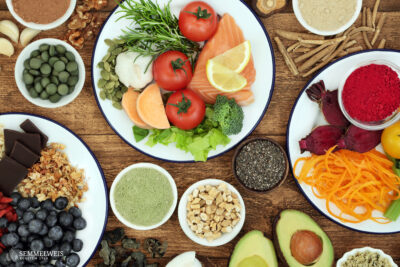Superfood is a term that is as overblown as it is misleading. In principle, it is used to describe ingredients that offer more health benefits than other products because of their nutritional composition. In reality, however, these benefits are not supported by scientific studies, explains Adrienn Szabó, a dietician at Semmelweis University’s Department of Surgery, Transplantation and Gastroenterology (STéG). Adrienn Szabó stresses that people who never eat “superfoods” do not suffer from any nutrient deficiencies.
 The dietician advises people who still insist on “superfoods” to choose the ones that are grown in their own country and do not have to be transported from far away. This is justified not only by ecological considerations, but also, for example, by the fact that out-of-season fruits and vegetables imported from far away usually contain more chemical residues – from chemicals used for post-ripening or, say, pest control -, and measurements show this.
The dietician advises people who still insist on “superfoods” to choose the ones that are grown in their own country and do not have to be transported from far away. This is justified not only by ecological considerations, but also, for example, by the fact that out-of-season fruits and vegetables imported from far away usually contain more chemical residues – from chemicals used for post-ripening or, say, pest control -, and measurements show this.
But it is a common misconception that transport significantly reduces the vitamin or mineral content of fruits and vegetables. However, they can lose some of their antioxidant content, which is also valuable for us, as they try to protect themselves from negative effects, the expert adds.
Adrienn Szabó points out that there are a lot of vegetables, fruits, grains, and nuts grown in Hungary that have “superpowers” and could thus justly be called superfoods.
The “superpowers” of garlic, beetroot, and – among fruits – blueberries are well known. But not many people know that flaxseed is perfectly competitive with chia seed in terms of its composition, with its high fiber and Omega-3 fatty acid content, the dietician points out. The antioxidant, fiber, and vitamin content of dried fruits is also especially high, with cornel, rosehip, and sour cherry, for example, being excellent substitutes for goji berries. It’s good to know that plain dried fruit has no added sugar, so even people who are watching their figure or are diabetic can eat it in moderation. The antioxidant content of prunes is very high, the expert emphasizes.
Green peas or broccoli that have been cooked for a short time and then blended are a great substitute for avocados, a third known “superfood;” by adding a little flaxseed, pumpkin seed, or even walnut oil we can make a green purée similar to avocado cream sauce, but even better in nutritional terms.
In addition, the dietician at Semmelweis University advises people who think there is no healthier fish than salmon to eat indigenous trout from the salmon family instead. It is also rich in Omega-3 fatty acids, which are beneficial to the cardiovascular system.
Adrienn Szabó concludes by stressing that the key to a healthy diet lies not in ingredients that are labelled superfoods, but in a varied and colorful diet. And why should you eat colorful foods?
Because colorful foods contain compounds that are beneficial to the body (antioxidants, polyphenols, phytonutrients), and the “coloring” compounds also have the capacity to bind free radicals and thus reduce inflammation. What is more, they provide energy for the microbiome, i.e. bacteria, viruses, and fungi that live in the alimentary canal. – Adrienn Szabó
 The “coloring” compounds are not only found in fruits and vegetables, but also in nuts and grains, especially in the inner part, the germ. In other words, even wholewheat bread can be a “superfood,” says Adrienn Szabó, giving another example of “superfoods” that can be found in Central and Eastern Europe. The dietician, whose book Magyar superfood (Hungarian Superfood) was published in 2020, recommends the following colorful vegetables for the winter season: red onions, red cabbage, black radish, pumpkin, savoy cabbage, mushrooms, and carrots; also, she suggests that those who prefer typically Hungarian flavors should feel free to use more onions and paprika when preparing dishes. If someone is looking for a real vitamin C bomb, they should go for the sea buckthorn pulp juice thinned with water, an excellent alternative to lemon water, the morning drink made from imported lemon.
The “coloring” compounds are not only found in fruits and vegetables, but also in nuts and grains, especially in the inner part, the germ. In other words, even wholewheat bread can be a “superfood,” says Adrienn Szabó, giving another example of “superfoods” that can be found in Central and Eastern Europe. The dietician, whose book Magyar superfood (Hungarian Superfood) was published in 2020, recommends the following colorful vegetables for the winter season: red onions, red cabbage, black radish, pumpkin, savoy cabbage, mushrooms, and carrots; also, she suggests that those who prefer typically Hungarian flavors should feel free to use more onions and paprika when preparing dishes. If someone is looking for a real vitamin C bomb, they should go for the sea buckthorn pulp juice thinned with water, an excellent alternative to lemon water, the morning drink made from imported lemon.
Éva Haiman
Translation: Dr. Balázs Csizmadia
Photo by Attila Kleb; illustration: iStock


